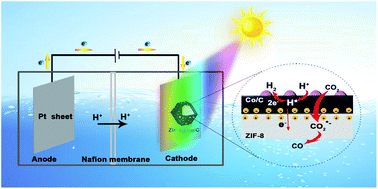A photo-activated process cascaded electrocatalysis for the highly efficient CO2 reduction over a core–shell ZIF-8@Co/C†
Abstract
Light irradiation can affect electronic properties of catalysts and the introduction of appropriate light into electrocatalysts may have a significant impact on the electrocatalytic process; however, this has not been fully studied. Herein, we propose a photo-activated process cascaded electrocatalysis for CO2 reduction to produce syngas over a core–shell ZIF-8@Co/C catalyst. Under light irradiation, the onset potential and overpotential of ZIF-8@Co/C positively shift by 40 and 200 mV, and the syngas production is enhanced 5.2-fold at a bias potential of −0.9 V vs. RHE. It is noteworthy that the electric energy efficiency is enhanced by 30%. Deducting syngas generated by electricity, the solar-to-syngas conversion efficiency (joule to joule) is as high as 5.38%, which outperforms reported photoelectrochemical systems. These devices also relatively maintain high efficiency in neutral pH aqueous solution. Dedicated experiments and in situ transient photovoltage studies demonstrate that the cascaded photo-activation of CO2 and H+ in electrocatalysis accounts for the outstanding catalytic performance.



 Please wait while we load your content...
Please wait while we load your content...